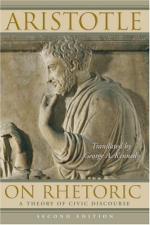
|
| Name: _________________________ | Period: ___________________ |
This test consists of 5 multiple choice questions, 5 short answer questions, and 10 short essay questions.
Multiple Choice Questions
1. As explained by Aristotle in Book II, Chapter 24, what else might a person equivocate?
(a) The meaning of words.
(b) The order of events.
(c) The use of words.
(d) The description of events.
2. How many periods of a lifetime did Aristotle discuss in Book II, Chapter 12?
(a) Three.
(b) Four.
(c) Two.
(d) Five.
3. According to Aristotle, what should vivid descriptions always depict?
(a) Something that is in activity.
(b) Something that is easily identified.
(c) Something that is stationary.
(d) Something that is not easily identified.
4. Which one of the following was not included in Aristotle's recommendations for orators on how to write and speak their arguments?
(a) Non-logical means.
(b) Abundance of detail.
(c) Convincing delivery.
(d) Eloquent style.
5. As explained by Aristotle in Book II, Chapter 18, what was political argumentation concerned with?
(a) Both past and future events.
(b) Past events.
(c) Neither past nor future events.
(d) Future events.
Short Answer Questions
1. What did Aristotle indicate was the result of using complex, foreign words?
2. In order for an enthymeme to be successful, what recommendation did Aristotle have about its conclusion?
3. Which of the following examples best demonstrates Aristotle's theory of possibility in Book II, Chapter 19?
4. Which view did Aristotle think people in their prime had of money?
5. What was the basic method used in the a fortiori argument that Aristotle referred to in Book II, Chapter 23?
Short Essay Questions
1. Which example did Aristotle use to display the fallacious ways an enthymeme could be formed?
2. In Aristotle's opinion, why were non-logical ways necessary to convince certain audiences of a sound argument?
3. As the second type of example, what were the two forms of the invented facts?
4. How might the antithesis sayings emphasize a particular point?
5. As explained by Aristotle, what four common mistakes were made while writing prose?
6. What were some of the characteristics of a refutative enthymeme?
7. What value could surprises have in a speech, and what were some of the forms they could take?
8. How did Aristotle explain the different kinds of arguments used by the three types of rhetoric in Book II, Chapter 18?
9. In what way did Aristotle describe the differences between written prose and spoken prose in Book III, Chapter 12?
10. What were some of the ways Aristotle described what was and was not possible in rhetoric and oratory?
|
This section contains 867 words (approx. 3 pages at 300 words per page) |

|




